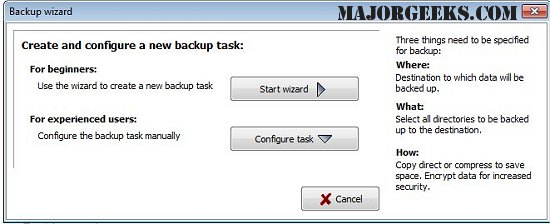Personal Backup has recently released version 6.4.2.0, a versatile tool designed to efficiently save personal data to various destinations, including local drives (both fixed and removable), Windows network servers, and FTP servers. Users have the flexibility to configure and store an unlimited number of backup tasks, selecting files for backup on a folder-by-folder basis. All subfolders are included automatically, but users can easily customize their selections by including or excluding specific subdirectories through selection or filters.
In addition to folder selection, users can apply additional criteria based on file type, age, and name filters. The software preserves the original directory structure under designated folders (e.g., LwC, LwD) without altering the original drives (C, D, etc.). For added convenience, files can be compressed using gzip format, either as a whole or organized by subfolders into zip files. Furthermore, users have the option to encrypt their data using the AES algorithm for enhanced security.
Key features of Personal Backup include:
- An intuitive wizard for creating new backup tasks.
- The capability to configure an unlimited number of backup tasks.
- The ability to backup complete directory structures.
- Options for on-demand backups or automated scheduling.
- FTP backup capabilities, including support for proxy settings and FTPS (FTP over SSL).
- Multiple backup options, allowing files to be saved into single files—either with or without compression, and organized in various formats (including zip files).
In summary, Personal Backup 6.4.2.0 is a powerful backup solution that caters to individual needs, providing a user-friendly interface and extensive customization options to ensure data security and integrity.
To extend the utility of Personal Backup, users might explore integrating it with cloud storage solutions for additional redundancy and accessibility. Additionally, incorporating features such as scheduling regular backups or setting up notifications for backup completions could enhance user experience. Adopting a comprehensive data management strategy that includes regular backups, system restore points, and file versioning can further safeguard against data loss
In addition to folder selection, users can apply additional criteria based on file type, age, and name filters. The software preserves the original directory structure under designated folders (e.g., LwC, LwD) without altering the original drives (C, D, etc.). For added convenience, files can be compressed using gzip format, either as a whole or organized by subfolders into zip files. Furthermore, users have the option to encrypt their data using the AES algorithm for enhanced security.
Key features of Personal Backup include:
- An intuitive wizard for creating new backup tasks.
- The capability to configure an unlimited number of backup tasks.
- The ability to backup complete directory structures.
- Options for on-demand backups or automated scheduling.
- FTP backup capabilities, including support for proxy settings and FTPS (FTP over SSL).
- Multiple backup options, allowing files to be saved into single files—either with or without compression, and organized in various formats (including zip files).
In summary, Personal Backup 6.4.2.0 is a powerful backup solution that caters to individual needs, providing a user-friendly interface and extensive customization options to ensure data security and integrity.
To extend the utility of Personal Backup, users might explore integrating it with cloud storage solutions for additional redundancy and accessibility. Additionally, incorporating features such as scheduling regular backups or setting up notifications for backup completions could enhance user experience. Adopting a comprehensive data management strategy that includes regular backups, system restore points, and file versioning can further safeguard against data loss
Personal Backup 6.4.2.0 released
Personal Backup saves personal data to any destination folder located on a local fixed or removable drive, Windows network server, or an FTP server.


